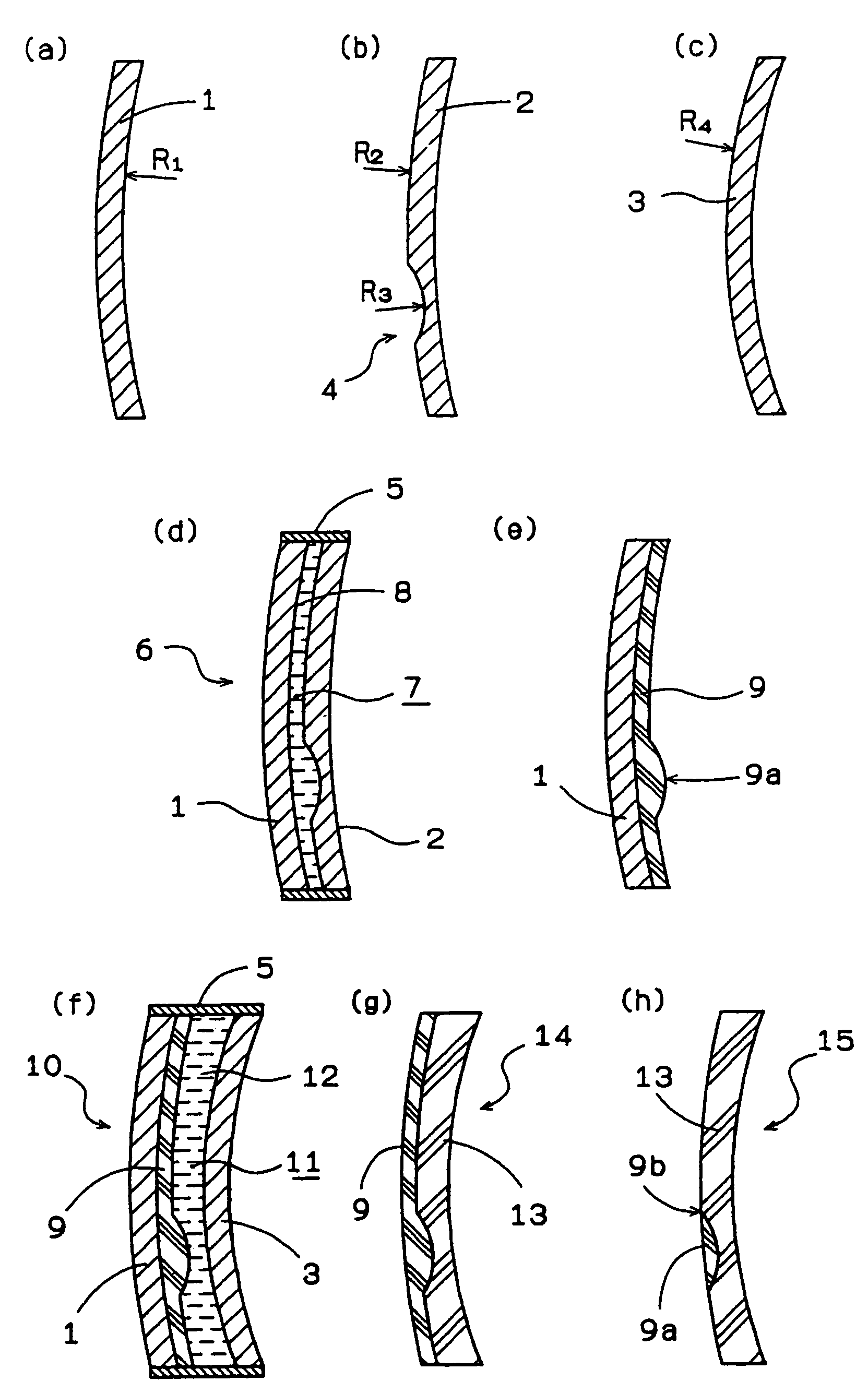Bifocal plastic lens
a plastic lens and bifocal technology, applied in the field of bifocal plastic lenses, can solve the problems of hard release in the molding process, hard handling of the molding step, and difficulty in respecting processing
- Summary
- Abstract
- Description
- Claims
- Application Information
AI Technical Summary
Benefits of technology
Problems solved by technology
Method used
Image
Examples
example 1
[0025]In FIG. 1, (a) and (b) are typical sectional views showing a pair of glass molds, which will be hereinafter simply referred to as sectional views. Moreover, a radius of curvature will be simply referred to as a curvature. Radius of curvatures R1 and R2 of molding surfaces of molds 1 and 2 give the same spherical surfaces. The surface having the radius of curvature R2 is provided with a concave portion 4 having a radius of curvature R3 which molds a small lens. FIG. 1(c) is a sectional view showing a mold 3 for molding a concave surface side of a compound lens which will be described below, and the molding surface has a radius of curvature of R4. FIG. 1(d) shows a shell 6 in which peripheral edge portions of the molds 1 and 2 are sealed with a tape 5. A first monomer 8 is cast into a cavity portion 7 in the shell and is heated and polymerized, and the mold 2 is released so that a preparatory lens member 9 including a small lens 9a shown in FIG. 1(e) is obtained. At this time, t...
example 2
[0037]Next, description will be given to another embodiment of the compound lens. FIG. 2(a) shows a mold 16 in which a small lens molding surface is formed on a concave surface side. The concave surface side for molding a bench lens is a spherical surface having a radius of curvature of R5 and is provided with a concave portion 4a having a radius of curvature of R7 which molds a small lens. FIG. 2(b) shows a mold 17 forming a convex surface side of the bench lens, and the convex surface has a radius of curvature of R6. By using these molds, a peripheral edge portion is sealed with a tape 5 to create a shell 18, and the first monomer 8 is cast into a cavity portion 19 and is heated and polymerized and the molds are then released as shown in FIG. 2(c) so that a preparatory lens member 20 including a small lens 20a shown in FIG. 2(d) is obtained. As shown in FIG. 2(e), then, the preparatory member 20 and a mold 21 having radius of on a concave surface side which is equal to a radius of...
example 3
[0047]While the monomer having a high refractive index of 1.737 has been used in the example 1, description will be given to an example in which the same object can be achieved even if the refractive index is varied.
[0048]First monomer: MR-7 manufactured by MITSUI CHEMICALS, INC., Nd=1.660
[0049]Second monomer: CR-39 manufactured by PPG, Nd=1.498
[0050]In order to adhere these monomers, it is necessary to first polymerize and cure the second monomer and to then cast the first monomer. For the mold, a mold shown in FIG. 5 is used.
[0051]R5 (radius of curvature on a concave surface side of a mold 30)=332.5 (mm)
[0052]Radius of curvature on a concave surface side of a mold 33)=332.5 (mm)
[0053]R7=radius of curvature on an eye-facing side of a small lens
[0054]Table 3 shows a result obtained by calculating an additional power and the radius of curvature R7 on an eye-facing side of a small lens in the same manner as in the example 1. In comparison for an additional power of 3.00, R7 is 66.86. ...
PUM
 Login to View More
Login to View More Abstract
Description
Claims
Application Information
 Login to View More
Login to View More - R&D
- Intellectual Property
- Life Sciences
- Materials
- Tech Scout
- Unparalleled Data Quality
- Higher Quality Content
- 60% Fewer Hallucinations
Browse by: Latest US Patents, China's latest patents, Technical Efficacy Thesaurus, Application Domain, Technology Topic, Popular Technical Reports.
© 2025 PatSnap. All rights reserved.Legal|Privacy policy|Modern Slavery Act Transparency Statement|Sitemap|About US| Contact US: help@patsnap.com



